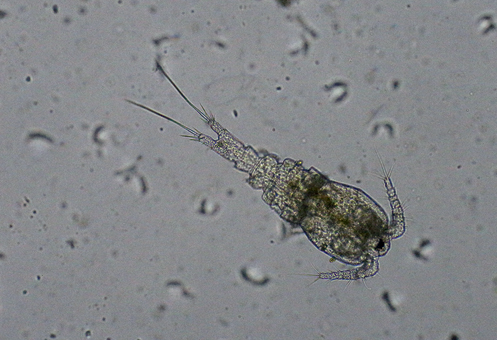
21 |
Text by Cecile Reed |
|---|---|
Copepods and their allies
Subclass Copepoda
A subclass of the phylum Arthropoda and although typically small (with bodies 1–5mm in length), among the most abundant multicellular organisms in marine and lentic freshwater systems. Of the approximately 13,000 species, 2,814 live in fresh waters, of which 53 occur in South Africa. Free-living copepods typically comprise a head bearing well-developed mouthparts, antennae and often a single compound (nauplius) eye, a six-segmented thorax with swimming appendages and a five-segmented abdomen that lacks appendages. However, various body segments are fused in different subgroups, and in parasitic forms the entire body may be radically modified, sometimes with loss of visible segmentation and limbs. Life cycle typically has four stages: egg, nauplius larva, copepodite and adult.
1 Calanoid copepods
Order Calanoida


© C. GRIFFITHS

© C. GRIFFITHS
Mostly marine, but 24 species from one family (Diaptomidae) occur in freshwater systems in southern Africa, all endemic to the region. Bodies cylindrical and often pigmented with carotenoid pigments (1), which show as red, orange and indigo, located in fat globules and other structures. Distinguishing features include antennae that are at least half the body length, and biramous (branched) second antennae. Females (1a) carry paired egg sacs. Size: Body 1–5mm in length. Biology: Very abundant and occupy an intermediate position in the aquatic food chain, feeding on small invertebrates that have consumed phytoplankton. Most are omnivorous, feeding on algae, other plant material, protists and rotifers. Lovenula (1a) is carnivorous and easily recognised by the enlarged blade-like mouthparts.
2 Harpacticoid copepods
Order Harpacticoida


© C. REED
Mostly benthic, living on, burrowing into, or living in pore water between particles in bottom sediments. In South Africa, only five freshwater species known. Easily told from other copepods by their very short antennae. Body (2) sometimes worm-like, with heavily armoured widened abdomen, rows of spines and spinules, and no division between thorax and abdomen. Females with single egg sac. Size: <1mm in length. Biology: Feed on microalgae, protists, bacteria and detritus particles and are important food source for larger invertebrates and fishes.
3 Cyclopoid copepods
Order Cyclopoida


© C. REED

© C. REED

© C. REED
Most abundant group of freshwater copepods; widely distributed globally, including in southern Africa. Body typically teardrop-shaped. Distinguished from other copepods by antennae that are shorter than head plus thorax; second antennae (3) uniramous. Antennae of males (3a) modified for grasping females. Females (3b) carry paired egg sacs. The order also includes most of the parasitic copepods, in the families Lernaeidae (see 4, below) and Ergasildae. Size: Free-living species approximately 1mm in length; parasitic species <1mm in length. Biology: Mostly planktonic in water column. Grasp feeders, eating food generally larger than that eaten by calanoids. Diet includes algae, rotifers, nematodes, copepods, crustaceans, chironomids and larval fish.
4 Anchor worms
Family Lernaeidae


© L. VAN AS
Highly modified cyclopoid copepods, exclusively parasitic on freshwater fishes; Lamproglena and Lernaea most common genera. Size: 1–20mm in length. Biology: Attach to skin and gills of host using enlarged maxillae. Females (4) easily identified by presence of two large elongate white egg sacs. Males less modified than females. Feed by rasping the host’s body surface with mandibles. Lamproglena hepseti, from Southern pike (Hepsetus cuvieri) (p.110, 3) in Botswana, is illustrated.
Fish lice
Subclass Branchiura
Not Copepoda, but another subclass of Crustacea easily confused with copepods. Body oval, flattened and covered by wide carapace. Females larger than males, with two large, elongate, white egg sacs. Restricted to fresh waters. Attach to skin of fish in body areas subject to least turbulence. Mouthparts and first pair of antennae modified for parasitic way of life. Feeds on host blood and mucus.
5 Fish louse
Chonopeltis liversedgei


© L. VAN AS
One of four species described in this genus, all endemic to Africa. Body slender; carapace short, with anterior carapace lobe large and rectangular; abdomen long. No pigmentation pattern. Size: Female approximately 9mm in length; male 6.7mm. Biology: All life stages parasitic; leave their hosts only to mate. Eggs hatch into parasitic post-nauplius larvae. Damages host integument through feeding and attachment. Chonopeltis liversedgei, described from Western bottlenose (Mormyrus lacerda) (p.96, 3) from Botswana, is illustrated.